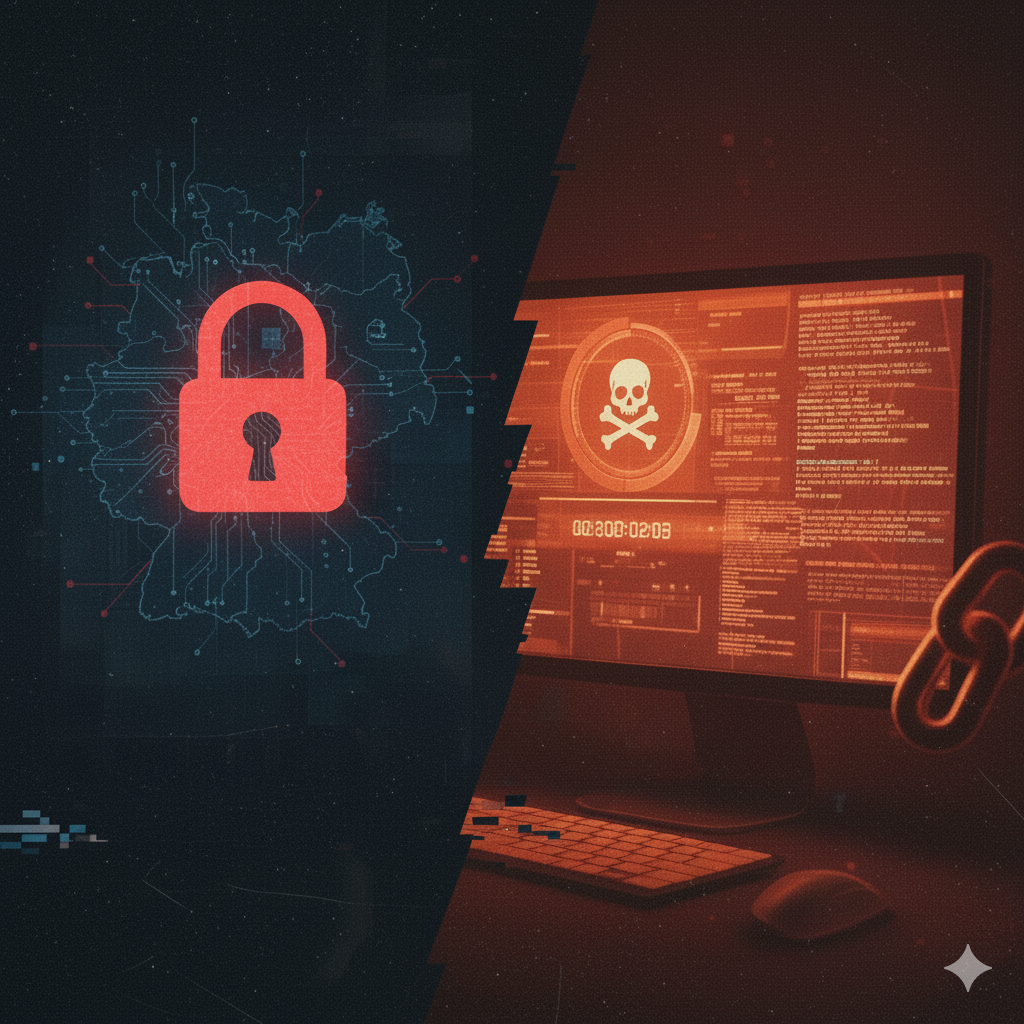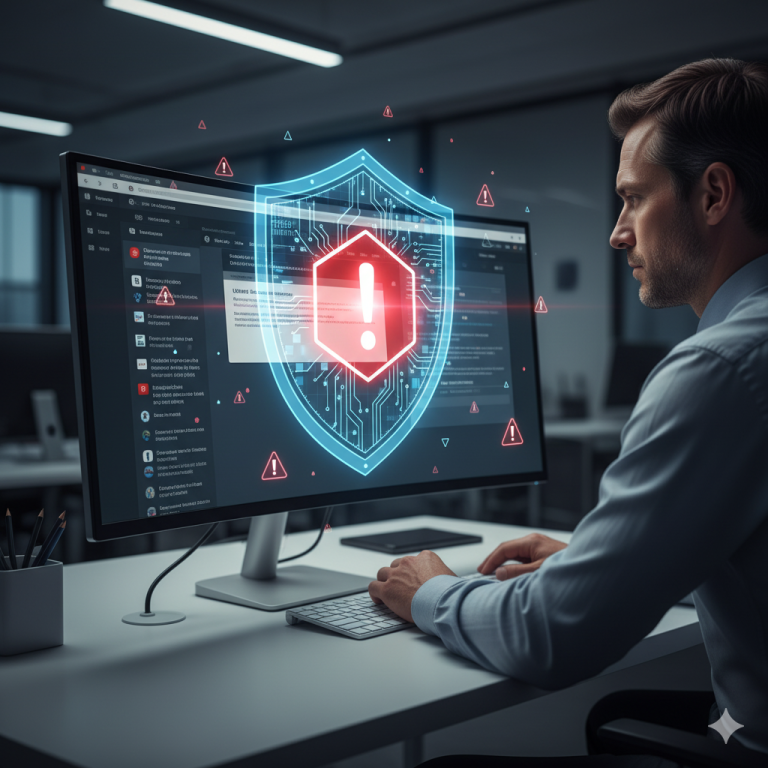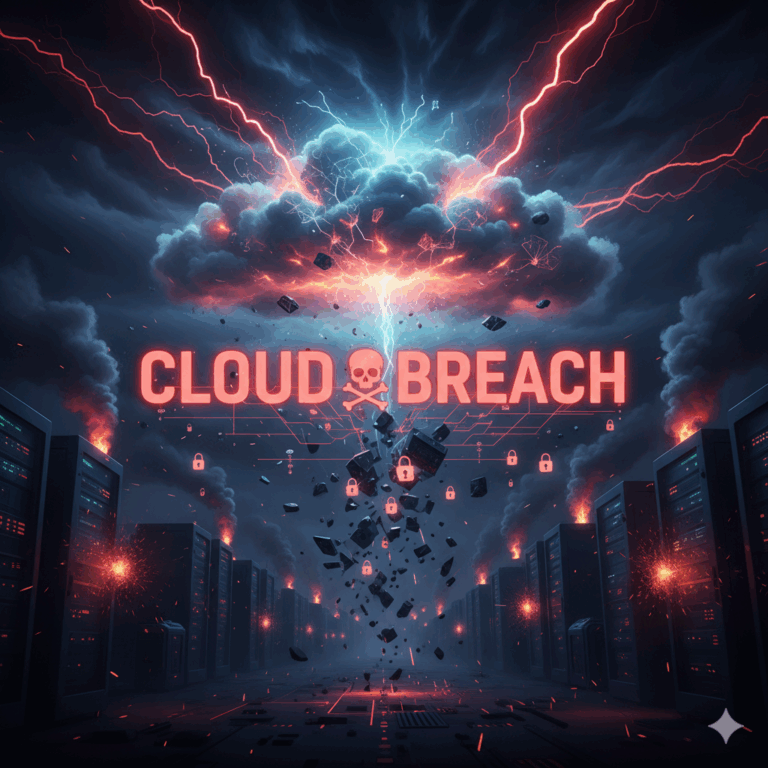Ransomware is no longer just a buzzword in the cybersecurity community — it has become one of the most disruptive and costly threats to businesses worldwide. What once started as opportunistic attacks against individuals has now evolved into highly professionalized, organized crime operations, capable of crippling entire corporations or even endangering lives in critical infrastructure.
Germany, as one of Europe’s strongest economies, has become a prime target for such attacks. From global industrial players to local service providers and hospitals, no sector is safe. In recent years, German companies like Pilz GmbH have seen their operations grind to a halt, while hospitals in Düsseldorf experienced tragic consequences from IT systems being taken offline. Even medium-sized businesses — the backbone of the German economy — are increasingly targeted, as ransomware groups know many of them lack the same defenses as global corporations.
The growing trend of double extortion (encrypting files and threatening to leak stolen data) has raised the stakes further. Paying a ransom is not just about restoring operations; it’s also about protecting sensitive customer data, intellectual property, and reputation. Yet, as multiple German cases have shown, even companies with advanced technical expertise can fall victim.
In this article, we’ll explore real-world ransomware incidents in Germany — from the well-documented attack on Pilz to the “Malibu” case from a documentary, and even a ransomware strike on a Düsseldorf hospital that sparked international headlines. Each story illustrates not only the immediate chaos ransomware causes but also the long-term lessons that organizations of any size can take to strengthen their defenses.
1. What is Ransomware — Quick Overview
Ransomware is a form of malicious software designed to disrupt business operations by encrypting files or locking entire systems until a ransom is paid. Unlike traditional malware, which might spy on users or steal specific information silently, ransomware is loud, visible, and disruptive by design. Its goal is clear: force victims into paying money, usually in cryptocurrency, in exchange for a decryption key or the promise not to release stolen data.
Core Mechanism
Ransomware usually infiltrates systems through common entry points such as:
-
Phishing emails with malicious attachments or links.
-
Unsecured remote access points like VPN gateways or exposed RDP services.
-
Exploited vulnerabilities in outdated software or unpatched operating systems.
Once inside, the malware spreads laterally, seeking out servers, shared drives, and backups. Finally, it executes mass encryption or system lockdowns, effectively holding an organization hostage.
Double Extortion
Modern ransomware rarely stops at encryption. Many attacker groups now use double extortion tactics:
-
First, they steal sensitive data (e.g., customer information, contracts, financial records).
-
Then they encrypt local systems.
-
Finally, they threaten to publish or sell the stolen data if the ransom is not paid.
This evolution means even companies with good backup systems are at risk — because restoring files won’t undo the threat of a public data leak.
Ransomware-as-a-Service (RaaS)
Cybercrime has industrialized. Instead of lone hackers, many ransomware campaigns are run as business models. Developers create ransomware kits and lease them to affiliates, who then conduct attacks and share the profits. This model, known as Ransomware-as-a-Service (RaaS), has dramatically lowered the barrier to entry: even criminals with limited technical knowledge can now launch sophisticated attacks with global reach.
Pay or Refuse?
The toughest question for victims is whether to pay. On the surface, paying may seem like the fastest way to resume operations. However:
-
There is no guarantee the attackers will provide working decryption keys.
-
There is no guarantee that stolen data will be deleted and not sold on dark web markets.
-
Paying could even make a company a repeat target, as attackers may assume the victim will pay again.
-
In some jurisdictions, ransom payments may violate sanctions or create legal liabilities.
Consequences
The fallout from ransomware extends far beyond the ransom itself:
-
Operational shutdown: production lines stop, services are interrupted, customers are turned away.
-
Financial losses: not just ransom demands, but also downtime costs, incident response, legal fees, and potential fines.
-
Data loss & leaks: intellectual property, personal data, and confidential information can all be compromised.
-
Reputational damage: clients and partners may lose trust.
-
Legal repercussions: GDPR violations in the EU can trigger hefty penalties if personal data is exposed.
2. Case Study 1: Pilz GmbH (Germany)
The Pilz GmbH & Co. KG ransomware attack is one of the most cited German examples.
Timeline & Impact
-
Attack date: October 13, 2019, attributed to the BitPaymer ransomware strain.
-
Downtime: The company suffered global disruption for more than a week, with production temporarily halted.
-
Refusal to Pay: Reports indicate Pilz refused to pay the ransom, opting instead to restore and continue operations manually.
-
Manual Operations: Employees relied on paper, whiteboards, and phone communication to keep business running.
-
Takeaway: Even high-tech, automation-driven companies can fall victim — proving no one is immune.
Key Lessons
-
Ransomware targets SMEs and industrial companies alike.
-
Refusing ransom payments requires strong backup and recovery strategies.
-
Crisis readiness — emergency plans, tested communication lines, and backup workflows — makes the difference between survival and collapse.
3. Case Study 2: The “Malibu” Scenario (Documentary)
Unlike the Pilz case, the “Malibu” scenario does not come from an official press release or incident report, but rather from a German documentary. Still, it serves as a powerful illustration of how ransomware typically unfolds in medium-sized businesses (SMEs) — the backbone of the German economy. Because such companies often lack the same security budgets as large corporations, they make particularly attractive targets for ransomware operators.
Scenario Outline
-
Initial Access
The attack begins with something deceptively simple: a phishing email. An employee receives a message that appears to come from a trusted supplier. The attached PDF invoice looks legitimate, but once opened, it executes malicious code in the background. Within minutes, the attackers have a foothold in the company’s network. -
Lateral Movement
After gaining entry, the ransomware doesn’t immediately strike. Instead, attackers move laterally through the network — exploiting weak credentials, reusing passwords, and leveraging misconfigured systems. Slowly but surely, they escalate privileges and spread across servers, PCs, and shared network drives. -
Data Exfiltration & Encryption
Once key systems are under control, the attackers launch a two-phase strike:-
Data theft: Confidential customer data, internal contracts, and sensitive financial records are copied and exfiltrated.
-
Encryption: At the same time, local files and databases are encrypted. Employees suddenly lose access to critical tools, from ERP systems to email.
-
-
Ransom Demand
The attackers then reveal themselves with a ransom note. The message is clear: pay a significant sum in Bitcoin or Monero, or risk permanent data loss and public exposure of stolen information. A countdown timer adds psychological pressure, reminding executives that every hour without payment increases the danger of leaks. -
Crisis Point
Management faces a painful dilemma:-
Pay the ransom and hope the attackers keep their word.
-
Refuse payment, risking operational collapse and reputational ruin.
Meanwhile, employees are paralyzed, unable to carry out their daily work. Customers begin calling, demanding answers. The company’s reputation hangs in the balance.
-
-
Incident Response
At this stage, external IT forensic experts and crisis response teams are called in. Their first tasks: isolate infected systems, stop the spread, and identify the point of entry. Backups are checked — and luckily, some clean versions exist. Restoring them, however, is a slow and painful process, taking days or even weeks. -
Aftermath
Even after systems are restored, the damage is done:-
The company has lost revenue during downtime.
-
Its reputation with clients is shaken.
-
Legal teams must assess potential GDPR violations due to leaked personal data.
-
Employees need retraining to prevent future incidents.
While the company survives, the recovery costs exceed the ransom demand itself — a bitter but valuable lesson.
-
Why This Example Matters
-
Human error at the center: A single phishing email opened the door. This highlights how awareness training and email security are critical first lines of defense.
-
Escalation is fast and stealthy: Attackers don’t just encrypt files immediately; they prepare, expand, and maximize impact before revealing themselves.
-
Preparedness saves lives (and companies): Having working backups, an incident response plan, and external security partners can mean the difference between recovery and collapse.
-
A mirror for many SMEs: The “Malibu” story resonates because it’s not unusual — it could happen to almost any mid-sized business in Germany tomorrow.
4. Case Study 3: Düsseldorf University Hospital
One of the most tragic ransomware incidents in Germany unfolded in September 2020, when Düsseldorf University Hospital — a major medical center with more than 1,000 beds — became the victim of a cyberattack. Unlike most ransomware cases that “only” disrupt business operations, this attack highlighted how ransomware can directly threaten human lives when it targets critical infrastructure.
Timeline & Impact
-
Attack date: On September 10, 2020, the hospital’s IT systems were suddenly taken offline by a ransomware infection. The malware was originally aimed at a university system but spread into the hospital’s network.
-
System disruption: Key medical IT services — including patient admission systems, diagnostic platforms, and email — became unavailable. The hospital had no choice but to suspend emergency care.
-
Patient rerouting: Emergency patients were redirected to other hospitals in the region. One critically ill patient was transferred to a facility nearly 30 kilometers away, resulting in a delay in treatment. Tragically, the patient later died.
Legal and Ethical Debate
-
Investigation by prosecutors: German authorities opened a criminal investigation into the case — marking the first time globally that a death was potentially linked to a ransomware attack. Prosecutors explored whether the attackers could be charged with negligent homicide.
-
Causality challenges: In the end, investigators concluded that the patient’s death could not be legally attributed directly to the ransomware attack, as the underlying health condition itself was severe and potentially fatal. The case was closed without charges.
-
Ethical implications: Even though causality could not be proven in court, the incident sparked a global debate: should ransomware groups targeting hospitals during the COVID-19 pandemic be considered perpetrators of crimes against humanity?
Aftermath and Response
-
Immediate recovery: IT specialists worked around the clock to restore critical systems. The hospital slowly resumed emergency care after about two weeks.
-
National security concerns: The incident prompted the German government and the Federal Office for Information Security (BSI) to call for stricter cybersecurity measures in healthcare institutions.
-
Global warning: International media covered the case, framing it as a wake-up call for all healthcare providers. The attack underscored that ransomware is not just about money — it can cost lives.
Key Lessons
-
Critical infrastructure is uniquely vulnerable
Hospitals and healthcare systems often rely on outdated IT, legacy medical devices, and interconnected networks, making them prime targets. -
Lives are at stake
Unlike factories or offices, a hospital shutdown has immediate, human consequences. Every minute of downtime can affect patient care. -
Attackers don’t always intend collateral damage
In this case, reports suggest the attackers did not specifically target the hospital but a university partner. Still, the consequences were devastating — proving that collateral damage is inevitable in ransomware campaigns. -
Legal accountability is complex
While morally clear, legally attributing a death to a cyberattack is difficult. This highlights gaps in current law enforcement and international cybercrime prosecution.
The Düsseldorf hospital attack highlights the devastating risks of ransomware in critical infrastructure. Beyond financial losses, such incidents can endanger human lives — making cybersecurity in healthcare a matter of urgency, not choice.
Read here the complette story about the Maleware Attack: https://www.wired.com/story/ransomware-hospital-death-germany/?utm_source=chatgpt.com5. Comparing the Cases
| Aspect | Pilz (Industry) | Malibu (SME Scenario) | Düsseldorf Hospital |
|---|---|---|---|
| Sector | Industrial automation | Medium-sized services/agency | Healthcare / critical infrastructure |
| Entry Point | Likely network/service vulnerability | Phishing email (social engineering) | Software/system vulnerability |
| Impact | Production shutdown, manual fallback | Data theft, reputational risk, financial loss | Patient care disruption, possible fatality |
| Strategy | Refused ransom, restored via backups | Incident response, forensic cleanup | Government/legal involvement |
| Lesson | Even high-tech firms need resilience | Phishing awareness + backups are critical | Critical sectors face highest stakes |
6. Key Takeaways for international Businesses
The three case studies — Pilz, the “Malibu” scenario, and Düsseldorf University Hospital — illustrate that ransomware is not a distant, theoretical risk but an immediate danger across industries worldwide. From industrial production to healthcare, attackers exploit the same weaknesses again and again. The following takeaways highlight what businesses of all sizes, in any country, should prioritize to reduce their risk and strengthen resilience.
1. Early Detection & Monitoring
The longer attackers remain undetected, the more thoroughly they can infiltrate systems, exfiltrate data, and maximize damage.
-
Practical steps: Implement Security Information and Event Management (SIEM) systems, anomaly detection, and 24/7 log monitoring.
-
German context: Many SMEs still lack continuous monitoring; outsourcing to managed security providers (MSSPs) can be a cost-effective alternative.
2. Network Segmentation & Least Privilege
Flat networks are a dream for attackers — once inside, they can move laterally with ease.
-
Practical steps: Use VLANs, firewalls, and access control lists to isolate sensitive systems. Limit user rights to what’s strictly necessary.
-
German context: In industrial environments (OT/ICS), segmenting production systems from office IT is essential to prevent downtime like in the Pilz case.
3. Backups, Tested Regularly
Backups are useless if they are outdated, corrupted, or also encrypted by ransomware.
-
Practical steps: Follow the 3-2-1 rule: 3 copies, on 2 different media, with 1 copy stored offline or in immutable cloud storage.
-
German context: Conduct regular recovery drills (“Notfallübungen”) to ensure staff can actually restore systems under pressure.
4. Incident Response Plans
When ransomware strikes, confusion is the biggest enemy. A predefined plan reduces chaos.
-
Practical steps: Define roles, escalation paths, and communication protocols in advance. Include external experts (forensics, PR, legal) in the plan.
-
German context: Under BSI requirements, critical infrastructure operators must have such plans; SMEs should adopt similar standards voluntarily.
5. Employee Awareness
Human error remains the number one entry point for ransomware.
-
Practical steps: Run phishing simulations, awareness campaigns, and short refresher trainings. Teach employees to verify suspicious emails and avoid risky clicks.
-
German context: German works councils (“Betriebsräte”) are often supportive of training, as it strengthens both company security and employee confidence.
6. Patch & Vulnerability Management
Attackers thrive on unpatched systems. Even widely known vulnerabilities often remain open for months.
-
Practical steps: Establish a structured patch management process with clear timelines for applying updates. Use automated vulnerability scanners.
-
German context: Many SMEs run legacy ERP or production systems that are hard to patch — compensating controls (firewalls, monitoring) become even more important here.
7. Legal & Regulatory Compliance
In the EU, data breaches can lead to severe GDPR fines in addition to reputational damage.
-
Practical steps: Maintain clear reporting procedures to the Data Protection Authorities (DPA) and affected customers.
-
German context: German regulators are strict. A company’s handling of an incident (transparency, speed, and diligence) can influence the size of penalties.
8. Cyber Insurance & Contracts
Cyber insurance can provide financial relief after an attack — but only if coverage is properly set up.
-
Practical steps: Review insurance contracts carefully to ensure ransomware and business interruption are covered. Define cybersecurity clauses in supplier contracts to share responsibility.
-
German context: German insurers are increasingly limiting ransomware coverage; businesses must check exclusions and meet strict minimum security requirements.
9. Penetration Testing & Continuous Assessment
Prevention is stronger than cure. Testing defenses before attackers do is critical.
-
Practical steps: Conduct regular penetration tests, red team exercises, and vulnerability scans. Prioritize fixing the highest-risk findings.
-
German context: The BSI recommends continuous security testing. For SMEs, affordable alternatives include regional IT security initiatives or cooperative audits.
For German businesses, ransomware resilience requires more than just firewalls and antivirus tools. It’s about a comprehensive approach:
-
Technology (monitoring, backups, segmentation)
-
People (awareness, training, crisis readiness)
-
Processes (incident response, compliance, contracts)
The three case studies — Pilz, the “Malibu” scenario, and Düsseldorf University Hospital — clearly demonstrate that ransomware is not a distant or isolated threat but a global challenge affecting every industry. From manufacturing and industrial automation to healthcare and service providers, attackers exploit the same vulnerabilities: weak defenses, unpatched systems, and human error.
For businesses of all sizes, the lessons are universal. Early detection, network segmentation, reliable backups, employee awareness, and tested incident response plans are not optional extras but critical pillars of resilience. Legal compliance, cyber insurance, and continuous testing further strengthen the defense posture.
Only by combining these elements into a holistic security strategy can organizations reduce their risk and ensure they are prepared — not if, but when ransomware strikes.
.
Conclusion – real examples of ransomware attacks on companies
Ransomware is not an abstract threat — it is a daily reality for companies in Germany. From industrial leaders like Pilz to critical sectors such as hospitals, the message is clear: no one is safe without preparation.
Looking at real examples of ransomware attacks on companies such as Pilz, the “Malibu” scenario, and Düsseldorf University Hospital, one thing becomes crystal clear: ransomware is not an abstract IT problem — it is a business-critical threat that can disrupt operations, damage reputations, and even put lives at risk.
From industrial automation to healthcare, attackers exploit the same weaknesses: outdated systems, insufficient monitoring, human error, and the absence of structured incident response. The Pilz case showed the importance of backups and business continuity planning. The Malibu scenario highlighted how quickly a single phishing email can escalate into a full-blown crisis. And the Düsseldorf hospital incident proved that ransomware can go beyond financial damage and directly affect human safety.
The lesson for businesses is simple yet urgent: preparation is the only effective defense. This means investing in monitoring, employee training, backup strategies, and tested response plans. It also means treating cybersecurity not as a cost center but as a strategic priority that protects long-term business continuity.
Ransomware will not disappear. But companies that take these lessons seriously will not only reduce their risk — they will also gain resilience, confidence, and trust in the eyes of their customers, partners, and regulators.
Please also read:
All computers locked – what to do in the event of a ransomware attack?
The WannaCry Hack: How a Virus Could Spread Worldwide in Hours
Follow me on Facebook or Tumblr to stay up to date. Connect with me on LinkedIn Take a look at my services And for even more valuable tips, sign up for my newsletter





